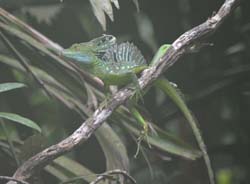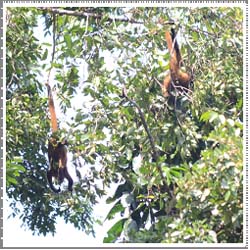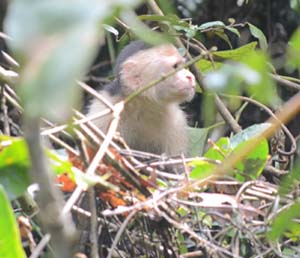NSTA Professional Development Trip: Part IV
By Lauren Jonas, NSTA Assistant Executive Director
Posted on 2012-07-28
 Exploring the Canals around Tortuguera
Exploring the Canals around Tortuguera
NSTA Costa Rica Trip Day 3
July 26, 2012
(posted on behalf of Greg Neff)
We departed Evergreen lodge at 8:30 am in a boat to explore the canals connecting three rivers in the Tortuguero area. Took a 2 1/2 hour trip through the canals. We observed and identified 31 different species of flora and fauna on this tour.
 As mentioned on an earlier posting, the lumber company built the canals to access a greater amount of the commercially viable trees. However, trees had to be floated in rafts down the canal to the coast where they could be processed and shipped. The Almendro tree, avery dense and massive tree with excellent wood, was not harvested because it would not float. This was very beneficial to the area because these almendro trees are an ecosystem in themselves. They host massive amounts of vines, bromeliads, orchids, reptiles, and birds. Most notable is the Great Green Macaw, 90% of which nest in almendro trees. The fruit of the almendro also is a major part of their diet.
As mentioned on an earlier posting, the lumber company built the canals to access a greater amount of the commercially viable trees. However, trees had to be floated in rafts down the canal to the coast where they could be processed and shipped. The Almendro tree, avery dense and massive tree with excellent wood, was not harvested because it would not float. This was very beneficial to the area because these almendro trees are an ecosystem in themselves. They host massive amounts of vines, bromeliads, orchids, reptiles, and birds. Most notable is the Great Green Macaw, 90% of which nest in almendro trees. The fruit of the almendro also is a major part of their diet.
Almendro trees in other areas of CR that are more accessible have been harvested, and this has devastated the Green Macaw population of CR. It is estimated that there are approximately 200 Green Macaws remaining in CR. The macaw has a distinctive raucous call that can be heard a long distance away. We heard them coming then observed a group of 7, then moments later a pair, flying high overhead.
 Encountered a family of white faced monkeys, pulled the boat under some trees and soon were within reach of at least 4 juveniles. Acting oblivious to our presence, these monkeys climbed the bushes next to us and about 1 meter overhead. The white faced monkey, better known as the Capuchin monkey, is omnivorous, eating insects, small animals, fruit, and nuts. They travel great distances in a day and virtually sweep through the forest as they go. Their diet requires large tracts of land for habitat, thus they are not found in small forested areas. We also observed 2 groups of spider monkeys. Spider monkeys are more specific in their diet and can live in much smaller tracts of land.
Encountered a family of white faced monkeys, pulled the boat under some trees and soon were within reach of at least 4 juveniles. Acting oblivious to our presence, these monkeys climbed the bushes next to us and about 1 meter overhead. The white faced monkey, better known as the Capuchin monkey, is omnivorous, eating insects, small animals, fruit, and nuts. They travel great distances in a day and virtually sweep through the forest as they go. Their diet requires large tracts of land for habitat, thus they are not found in small forested areas. We also observed 2 groups of spider monkeys. Spider monkeys are more specific in their diet and can live in much smaller tracts of land.
Returned to the Evergreen lodge for lunch, then off to visit the elementary school in the village.
Disclaimer: The views expressed in this blog post are those of the author(s) and do not necessarily reflect the official position of the National Science Teaching Association (NSTA).


